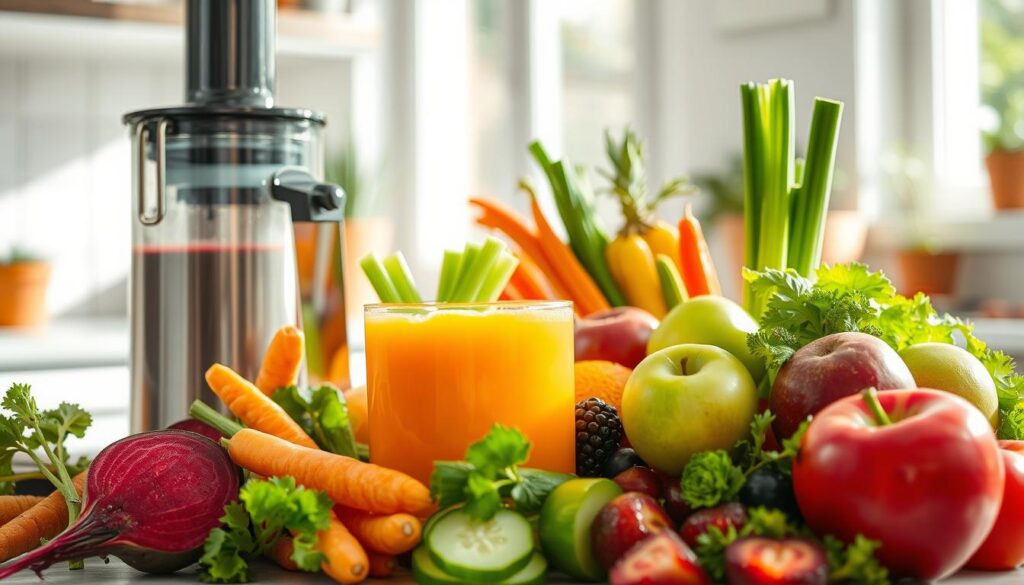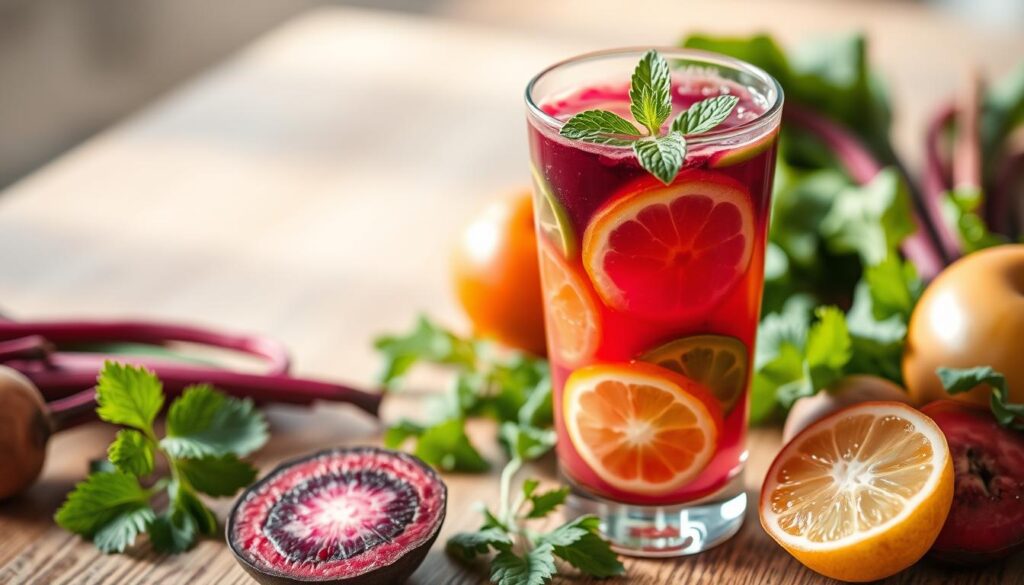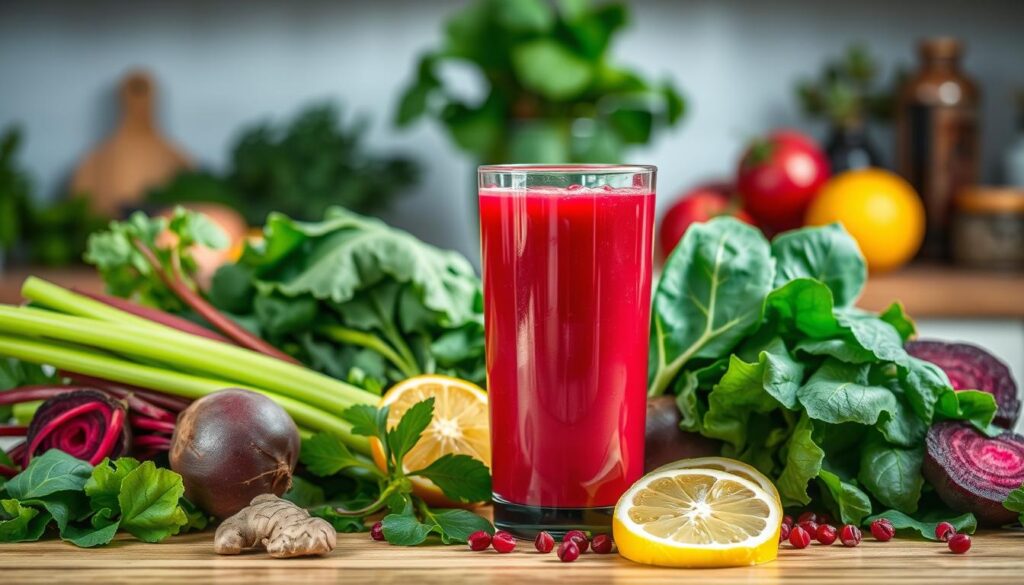If you’re struggling with high blood pressure, you’re not alone. Millions of Americans face this common issue. It raises the risk of heart disease and stroke. But, there’s a simple way to help manage it – juicing.
Dr. Norman W. Walker was a juicing pioneer. He showed how fresh, nutrient-rich juices can boost health and lower blood pressure. By juicing and eating healthy, you can control your blood pressure and heart health.
The NHS Eatwell Guide suggests drinking juices daily. It sees juices as a key part of high blood pressure juice recipe, natural remedy juice, and blood pressure management.
Key Takeaways
- Juicing can be a powerful natural remedy for managing high blood pressure
- Dr. Norman W. Walker’s pioneering work has highlighted the benefits of fresh juices for overall health and hypertension reduction
- The NHS Eatwell Guide recommends incorporating juices as part of your daily 5-a-day fruit and vegetable intake
- Combining juicing with a healthy diet and lifestyle can effectively lower your blood pressure
- Juicing provides a convenient and delicious way to increase your intake of nutrient-rich fruits and vegetables
Understanding High Blood Pressure and Natural Remedies
Hypertension is a serious health issue. It can cause big problems if not treated. Natural remedies, like juicing, can help manage it.
What Causes Hypertension
Hypertension is caused by many things. These include:
- Genetics and family history
- Unhealthy diet, especially high in sodium
- Sedentary lifestyle and lack of exercise
- Stress and poor stress management
- Underlying health conditions like obesity, diabetes, or kidney disease
The Role of Natural Solutions
Many people use natural remedies for hypertension. They choose heart-healthy drinks like juices.
Benefits of Juice-Based Approaches
Juicing is a tasty way to get important nutrients. These nutrients help keep blood pressure healthy. Juices with beets, spinach, carrots, and citrus fruits can:
- Make blood vessels wider and improve blood flow
- Lessen inflammation and oxidative stress
- Help the heart work better and support cardiovascular wellness
- Make nutrients easier to absorb for better health
Adding a hypertension drink to your day can help manage blood pressure. It supports your cardiovascular wellness.
“Juicing is a powerful tool in the fight against high blood pressure. By flooding your body with essential nutrients, you can help support healthy blood vessels and promote overall cardiovascular health.”
The Science Behind Juicing for Blood Pressure Management
Drinking anti-hypertensive smoothies and low-sodium juices can help with high blood pressure. These juices have lots of nutrients. Vegetables like spinach and beets have nitrates that improve blood flow. Fruits like oranges and apples are full of potassium, which fights sodium’s effects.
Antioxidants in these juices also protect cells from damage. This damage can lead to high blood pressure. A study from Queen Mary University London showed beetroot juice lowers blood pressure. Drinking these juices often can help keep your heart healthy and blood pressure in check.
| Juice Ingredient | Nutritional Profile (per 8 oz serving) |
|---|---|
| Carrot Juice | 96 calories, 2g protein, 0.36g fat, 22g carbs, 2g fiber, 9g sugar |
| Passion Fruit Juice | 126 calories, 1g protein, 0g fat, 34g carbs, 0g fiber, 35g sugar |
| Cranberry Juice | 114 calories, 0g protein, 0g fat, 28g carbs, 0g fiber, 22g sugar |
| Apple Juice | 119 calories, 0g protein, 0g fat, 28g carbs, 0g fiber, 25g sugar |
Many studies show juicing helps with blood pressure. It increases nitric oxide in the blood. This helps lower blood pressure and keeps the heart healthy. Adding anti-hypertensive smoothies and low-sodium juices to your diet is a great way to manage blood pressure and feel better overall.
“Juicing provides concentrated nutrients that can help lower blood pressure. Nitrates in vegetables enhance blood flow, while potassium-rich fruits help counteract sodium’s effects.”
Essential Ingredients for Blood Pressure-Lowering Juices
Juicing is a great way to fight high blood pressure naturally. There are special ingredients that help lower blood pressure. These ingredients are key to making effective juices.
Nitrate-Rich Vegetables
Beets, spinach, and celery are full of nitrates. Nitrates help blood vessels open up and improve blood flow. Drinking beet juice can lower blood pressure a lot.
Potassium-Packed Fruits
Apples, oranges, and pineapple are full of potassium. Potassium helps control blood pressure. Adding these potassium-rich drink ingredients to your juice is good for your blood pressure.
Anti-inflammatory Additions
Ginger and turmeric fight inflammation and improve blood vessel function. Adding these to your DASH diet juice boosts its blood pressure-lowering effects.
Mixing these ingredients in your juices makes a healthy drink. Try different flavors and enjoy the health benefits of these juices.
High Blood Pressure Juice Recipe: The Ultimate Blend
Boost your heart health with this amazing high blood pressure juice. It’s made with veggies and fruits that are good for your heart. This juice helps control high blood pressure naturally.
The ultimate high blood pressure juice recipe calls for:
- 1 large beet
- 2 cucumbers
- 4 celery sticks
- 1 apple
- 1 large bunch of parsley
- 1 peeled lemon
- 1 knob of ginger
This juice is full of beets, which are great for your blood vessels. It also has cucumbers and apples for extra hydration and potassium. Celery, parsley, lemon, and ginger add more health benefits.
Change the amounts to fit your taste and how much you want. Drink this juice to help your heart and feel refreshed.
| Ingredient | Quantity | Nutrition Facts (per serving) |
|---|---|---|
| Beets | 3 large | Calories: 210, Carbs: 52g, Protein: 4g, Fat: 1g, Fiber: 12g, Sugar: 34g |
| Apples | 2 large | Potassium: 700mg (20% DV) |
| Carrots | 5 large | Nitrates: Help relax blood vessels |
| Ginger | 1 inch piece | Anti-inflammatory properties |
This juice is tasty and full of nutrients for your heart. Enjoy the natural health benefits of this special mix.

Equipment Needed: Choosing the Right Juicer
Choosing the right juicer is key for natural blood pressure management. There are two main types: masticating and centrifugal. Knowing their features and benefits helps you pick the best one.
Masticating vs Centrifugal Juicers
Masticating juicers, or “slow juicers,” use a single auger to press out juice. They keep more nutrients because they’re slower. Centrifugal juicers are faster and cheaper. They use a spinning blade to make juice.
Preparation Tips and Techniques
Getting the most from your juicer starts with good preparation. Always wash your produce well. Cut fruits and veggies into pieces that fit your juicer’s chute.
Choosing the right juicer and preparing well unlocks your juice’s full power. This helps lower blood pressure naturally.
Best Time to Drink Your Blood Pressure Juice
Adding a heart-healthy drink to your day can help control high blood pressure. The morning is the best time to have this drink.
Starting your day with juice is good for your blood pressure. It fights inflammation and boosts energy. Try to drink 1-3 servings every day.
Keep an eye on your blood pressure to see how the juice works. This helps you adjust your juice plan for better results.
“Drinking just 17 ounces of beet juice daily can enhance athletic endurance and increase oxygen use in athletes, thanks to the nitrates present.”
While mornings are best, try different times to see what works for you. Some like it before working out for extra energy. The goal is to make it a regular part of your life.

| Juice Ingredient | Benefits for Blood Pressure |
|---|---|
| Beets | Contain dietary nitrates that can lower blood pressure within a few hours of consumption. Raw beet juice is more effective than cooked beets. |
| Pomegranate | Pomegranate juice has been shown to reduce both systolic and diastolic blood pressure in clinical trials. |
| Tomatoes | Drinking unsalted tomato juice daily can significantly lower both systolic and diastolic blood pressure. |
| Green/Black Tea | Both green and black teas can reduce systolic and diastolic blood pressure, with green tea providing a greater reduction. |
| Hibiscus | Drinking two cups of hibiscus tea per day has been found to significantly lower blood pressure in people with stage 1 hypertension. |
Combining Juicing with the DASH Diet
Looking to control blood pressure naturally? Try mixing juicing with the DASH diet. The DASH diet focuses on fruits, veggies, whole grains, and lean proteins. These foods are great for juicing too.
Nutritional Synergy
Adding juices to your DASH diet can boost its benefits. Juices packed with leafy greens, beets, carrots, and citrus are full of good stuff. They help control blood pressure and keep your heart healthy.
Meal Planning Tips
- Begin with a DASH-friendly juice, like spinach, kale, celery, and apple. It’s a great way to start your day.
- Use juices as a side or with your DASH meals. This way, you get enough fruits and veggies.
- Try juices with tomatoes, bell peppers, and herbs. They add flavor and nutrients to your meals.
- Stick to one fruit juice a day. Choose vegetable juices more often to keep sugar and calories low.
Mixing juicing with the DASH diet is a smart move. It helps manage blood pressure and boosts heart health. Try new juice mixes and see how they fit with your DASH meals for better health.
Monitoring Your Progress and Results
It’s important to check how well your blood pressure plan works. This includes your juicing. Use a good blood pressure monitor every day at the same time. Also, write down how much juice you drink and your blood pressure numbers.
This helps you see patterns in your health. You can then change your plan if needed.
Talk to your doctor about your progress. They can help you change your plan if it’s not working. By watching your blood pressure and juice, you can make sure your smoothie is helping. You might need to make small changes to get better results.
Managing high blood pressure is a long journey. Watching your progress is key to staying on track. Keep an eye on your health and work with your doctor to reach your goals with juicing.


A Life-Changing Experience with This Weight Loss Supplement (Nagano Tonic)
I’ve always struggled with finding a weight loss solution that actually works for me. Like many, I’ve tried numerous diets, exercise routines, and supplements over the years—some worked for a short time, but nothing ever gave me long-term results. That was until I decided to try the weight loss supplement I found : Link to the Supplement.
From the moment I started using it, I noticed a difference. Not only did I feel more energized, but my cravings also became more manageable. The best part? I started seeing results much quicker than I anticipated! Over the course of just a few weeks, I noticed a significant reduction in belly fat and overall weight loss that I hadn’t been able to achieve before.
What makes this supplement stand out from all the others I’ve tried is how it supports me in my daily routine without any jitters or energy crashes. I’m able to stay focused and motivated, which has made it easier to stay on track with my diet and exercise plan.
This product truly exceeded my expectations, and I feel more confident and healthier than ever before. If you’re struggling with your weight loss journey like I was, I highly recommend giving this supplement a try. It’s been a game-changer for me, and I’m sure it can work wonders for you too!
Contant Them on email .. tonicnagano50@gmail.com
I’ve tried so many weight loss products over the years, but nothing worked like this supplement! Since I started using it, I’ve noticed a big difference in my energy levels and appetite control. In just a few weeks, I’ve lost weight and feel so much better. It’s been easy to stick with, and the results speak for themselves. Highly recommend this to anyone looking to make a real change!
This Nagano Tonic has been amazing! In just a few weeks, I’ve lost weight, feel more energized, and my cravings are under control. Highly recommend it!
Thats the link to purchase http://surl.li/iasppy